
Antique furniture is a valuable and fascinating aspect of interior design that adds a touch of elegance and history to any room. However, recognizing and determining the age of vintage furniture is challenging, particularly for those unfamiliar with collectible items.
Did you know that its feet are a crucial indicator for estimating a furniture’s age and worth? In this article, we’ll delve into the various foot styles frequently seen on vintage furniture and offer guidance on using them to determine the age and identity of antique pieces.
Whether you’re an experienced collector or new to antique furniture, knowing how to assess its age by its feet will help you make educated choices and appreciate each piece’s unique history.
Different Antique Furniture Foot Styles
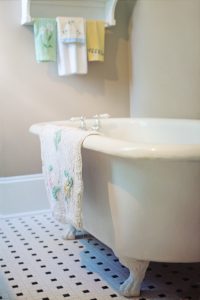
Let’s start by reviewing the antique furniture feet styles. Don’t forget to pay attention to the design of each one, as it plays a vital role in identifying them.
Ball and Claw Foot
The ball and claw foot is a distinctive and intricate leg style characterized by its resemblance to an animal’s claw or talon grasping a spherical or ovoid object, often referred to as the “ball.” With roots in China and later adoption by European furniture creators in the early 1700s, the ball and claw foot typically features a stylized, carved representation of a bird’s or a mythical creature’s claw with three to four curved talons or toes.
Their talons are often intricately detailed, showcasing feathers, scales, or other texture elements to emphasize their lifelike appearance. The claw surrounds and grasps a rounded object, a simple sphere, or an intricately carved orb, sometimes featuring geometric or floral patterns. In England and the American colonies, the ball and claw support is frequently connected to Queen Anne (1702-1714) and Chippendale (1750-1780) styles.
Cabriole Leg

The Cabriole leg features a smooth, continuous line that originates from the top of the leg, joins the antique furniture piece, and extends outward in a gentle convex curve. The Convex curve, known as the “knee,” transitions into a concave curve or “ankle” that terminates at the foot of the leg. The overall effect of the two connected curves creates a visually balanced and fluid form, imbuing the leg with a sense of movement and poise.
The foot of a Cabriole leg takes various shapes, such as a simple pad, a slipper, a ball, a claw, or a trifid foot. Leg styles range from plain and minimal to richly ornamented with carved details, such as acanthus leaves, shells, or other decorative motifs, particularly on the knee.
The Cabriole leg design first appeared in France during the early 1700s and gained popularity during Louis XV’s rule (1715-1774). It was commonly used in Queen Anne and early Georgian furniture in England.
Bun Foot
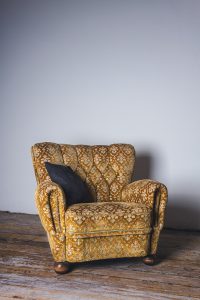
In the late 1600s, the Bun foot style was widely used in England and the American colonies as part of the William and Mary (1689-1702) era.
Bun feet are found on chests, case pieces, and upholstered seating furniture. Though its popularity waned in the 1700s, it experienced a resurgence during the Victorian period (1837-1901).
Bun foot styles typically feature a smooth, curved surface that tapers gently toward the base, creating a somewhat flattened or compressed appearance. Its furniture foot designs range from simple and unadorned to more elaborate, with carved details such as fluting, garlands, or other decorative motifs. The size of the Bun foot also varies, with some designs being more petite and others more substantial.
Bracket Foot
The Bracket foot style comprises two connected, perpendicular elements that form a right angle. The vertical component attaches to the corner of a furniture piece, such as a cabinet, chest, or desk, while the horizontal part extends outward to provide support. The leg style of the Bracket foot ranges from simple and understated to more elaborate, featuring carved or molded details such as scrolls, shells, or other decorative motifs.
The outer edge of the Bracket foot typically follows a gentle, sweeping curve that adds visual interest and softens the overall appearance of the foot. The inner edge, where the vertical and horizontal components meet, is often adorned with a small, triangular, or fan-shaped carving, enhancing the foot’s decorative appeal.
The design of these antique furniture feet originated in England during the early Georgian period (1714-1760) and was extensively used in American furniture of the same time.
Ogee Bracket Foot
Ogee Bracket foot features an S-shaped curve that flows gracefully along the outer edge, creating a visually striking silhouette. The curve begins with a concave section that transitions smoothly into a convex section, forming the classic “ogee” shape from which the foot derives its name. This double-curved profile adds a sense of movement and sophistication to the foot’s appearance.
Like the standard Bracket foot style, the Ogee Bracket foot comprises two perpendicular components that form a right angle. The vertical component attaches to the corner of a furniture piece, such as a cabinet, chest, or desk, while the horizontal component extends outward for support. The inner edge, where the vertical and horizontal parts meet, may feature a small, triangular, or fan-shaped carving to enhance the foot’s decorative appeal.
Gaining popularity in the mid-1700s, this leg style is linked to the Chippendale and late Georgian periods in England and America. It’s often found on high-quality case pieces, such as drawer chests and tallboy cabinets.
Trestle Foot
Trestle foot typically consists of a horizontal beam or stretcher that spans the width of a furniture piece, such as a table, bench, or bed frame. The beam provides the primary support for the furniture and is connected to the vertical legs at each end. In addition, the diagonal braces or supports may have been added to enhance stability and structural integrity, connecting the legs to the horizontal beam.
The diagonal elements take various forms, such as simple straight braces, curved braces, or more intricate designs featuring decorative motifs. The design of the Trestle foot style ranges from minimal and utilitarian to highly ornate, with carved or molded details such as foliage, geometric patterns, or other decorative elements. Some Trestle feet styles incorporate horizontal beams or stretchers at different levels for added support and visual interest.
Dating back to medieval times, Trestle bases were commonly found in Gothic furniture (12th-16th centuries).
Paw foot
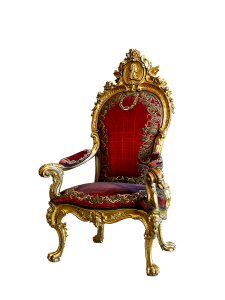
Paw foot is a unique and eye-catching leg style that resembles an animal’s paw, usually that of a lion. It became fashionable during the Empire period in France (1804-1814) and the Regency period in England (1811-1820), both known for their lavish and grand aesthetics.
The animal-inspired foot not only functioned as a decorative element, showing a sense of majesty and power to the furniture, but also provided structural support. Often used in chairs, tables, and case pieces, this foot style is defined by its intricately carved details, showcasing the talent and craftsmanship of artisans during that time.
Paw foot typically features a carefully carved representation of an animal’s paw, often resembling a lion’s, tiger’s, or other large feline’s paw. The paw may be depicted with varying degrees of realism, from highly detailed and lifelike renditions to more stylized or abstract interpretations. Individual toes, claws, and paw pads were usually clearly defined, focusing on texture and anatomical accuracy.
The furniture foot itself may be depicted resting on a flat surface or gripping a small object, such as a ball or a decorative ornament.
Sabot Foot
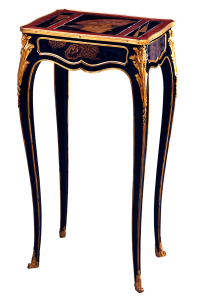
Sabot, also referred to as shoe foot, includes a small, rectangular, or slightly curved extension at the bottom of the furniture leg, evoking the appearance of a shoe or slipper.
Such antique furniture foot style first appeared in France during the 18th century and was frequently used in Louis XV and Louis XVI furniture (1715-1792). The Sabot foot style typically features a metal cap or sleeve, often made of brass, bronze, or other metal alloys, encasing the bottom of the furniture leg, such as on a chair, table, or cabinet.
The metal cap was designed to protect the wooden leg from wear and damage while adding elegance and refinement to the furniture piece. Shapes of the Sabot foot vary, from simple, straight-edged designs to more elaborate forms that follow the contours of the leg or incorporate decorative motifs, such as animal paws, hooves, or foliage.
The caps of the Sabot foot may be plain and unadorned or feature intricate engravings, relief work, or cast designs that add visual interest and sophistication. The metal was usually polished to a high shine, creating a striking contrast with the wooden leg, or finished with a more subtle patina that complements the overall design of the furniture piece.
Splayed Foot
The Splayed foot style is characterized by its outward-leaning position, which offers additional stability to the antique furniture. Foot styles like this were widespread in the late 18th and early 19th centuries, particularly during the Federal period in America (1780-1820) and the Sheraton and Hepplewhite styles in England.
A Splayed foot typically features a straight or slightly tapered leg that angles outward from the base of a furniture piece, such as a table, chair, or cabinet. The angle at which the leg was positioned helped to distribute weight more evenly across the floor, enhancing the stability and balance of the furniture.
The foot itself had a simple, unadorned appearance or incorporated subtle decorative elements, such as engravings or fluting, along the length of the leg.
The design of the Splayed foot varies in terms of the angle of the splay, the thickness of the leg, and the level of ornamentation. Some designs also incorporate a gentle curve to the leg or additional supporting elements, such as stretchers or braces, for added structural strength.
Marlborough Foot
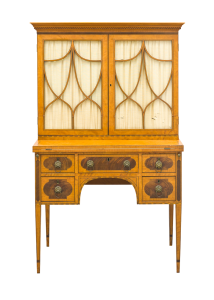
Marlborough foot is a straight, square, or rectangular foot style that originated in England during the early Georgian period (1714-1760). Named after the Duke of Marlborough, this foot style is often linked to the Palladian architectural style, which was popular during that time.
The Marlborough foot features a linear profile with clean, straight lines that emphasize its square or rectangular form. Footwear was typically unadorned, focusing on its functional and robust characteristics rather than ornamental details. Designed simply, it allows it to blend seamlessly with the overall aesthetic of the furniture piece, whether it be a desk, cabinet, or chest of drawers.
The Marlborough foot is typically found at the base of a furniture leg or directly attached to the lower edge of a case piece. The foot’s straight and squared-off design provides exceptional stability and sturdiness, making it a popular choice for larger and heavier furniture pieces.
Scroll Foot
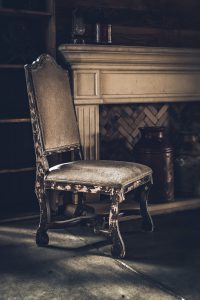
Scroll Foot is an elaborate, curved support pattern resembling a coiled parchment.
Such foot design is linked to the Baroque era (1600-1750) and was utilized in European and American furnishings. The curled support is often related to the William and Mary style in England, as well as the early Queen Anne period. Though the Scroll Foot’s popularity waned during the 18th century, it saw a resurgence during the Victorian period, particularly in Rococo Revival furnishings.
Scroll foot features a gracefully curved profile that begins at the base of a furniture leg or is directly attached to the lower edge of a case piece. The foot curls inward and upward, creating a rolled or coiled effect, similar to a rolled-up piece of parchment or a volute. The overall effect of the curve adds visual interest and a sense of movement to the foot, making it an eye-catching design feature.
Scroll foot designs range from simple and understated to highly ornate, with carved or molded details such as acanthus leaves, shells, or other decorative motifs adorning the surface of the curve. The furniture feet can be finished with various techniques, including gilding, painting, or staining, to enhance its visual appeal and complement the overall design of the antique piece.
Conclusion
In conclusion, the art of dating antique furniture by examining its feet is a valuable skill for collectors, enthusiasts, and interior design aficionados alike.
One can unlock the fascinating history behind each unique piece by familiarizing oneself with the various types of feet and their respective periods. This knowledge not only enriches the appreciation for the craftsmanship and cultural significance of antique furniture but also aids in making informed decisions when acquiring or appraising such pieces.
As you continue to explore the captivating world of antiques, remember that the secrets to a furniture piece’s age and origins often lie in the subtle details of its feet, serving as a testament to the passage of time and the evolution of design styles.

Leave a Reply